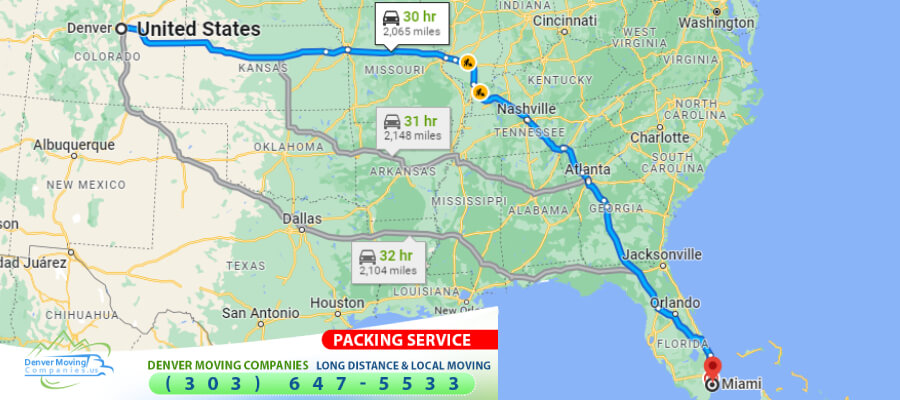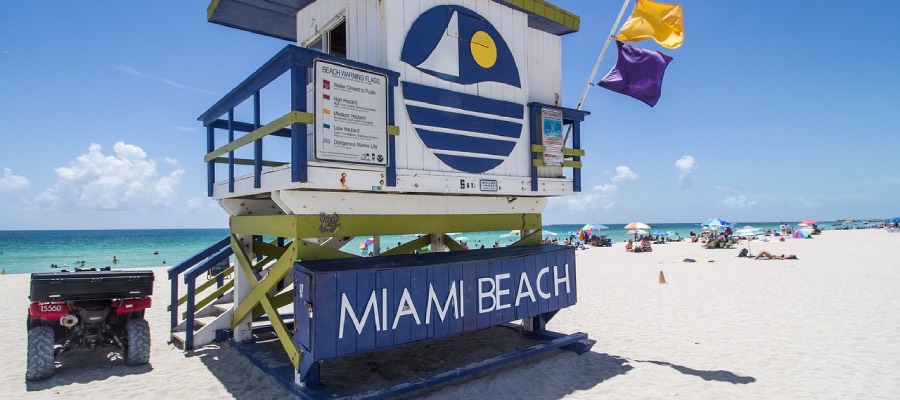Kissing the Rockies Goodbye: The Decision to Move
You may be considering moving from Denver to Miami, but you’re not quite sure. Relocating to a new city is always exciting, but before making any long-distance move, remember to research the city to which you plan to move. You’ll also want to check out information on the best long-distance movers to ensure a successful transition. Another option is to consider local long-distance movers since their prices are just as competitive. While both cities offer wonderful amenities for singles and families, you should also consider things like the cost of living, housing prices, and weather. What is the job market like in each city? Which city is more affordable? These are other factors you should think about when considering packing up and making the cross-country move to a different location.
Other factors to consider when moving to another state
- Weather-related issues
- The overall economy
- Out-of-state relocation
- The lifestyle and culture
- Budget
- Taxes
- Healthcare
- Transportation
- Education (if moving a family)
- Child care (if moving a family)
- Neighborhoods
- Air quality
Denver vs. Miami: A Tale of Two Cities
Before moving to another area, visit the city to get a feel for whether or not it’s the place for you. After all, you want to be satisfied with your choice of cities. If you’ve been a Denverite for several years, plan at least one visit to Miami to know whether or not you’re up for climate change and the vast difference in lifestyle.
Miami Weather: Miami’s humid summers are wet and mostly cloudy, while the winters are mostly dry, windy, comfortable, and clear. Over the course of a year, the temperatures vary from 65𐩑F to 90𐩑F but rarely dip below 50𐩑F or above 93𐩑F. The best time of the year to plan a visit to Miami Beach for warmer weather activities is between early November to mid-late April. This is the time when it’s warm and not uncomfortably sticky and humid. The hot summer season lasts for 3.9 months, from approximately June 5th to September 30th, with an average daily high above 87𐩑F. The hottest month is typically August, which boasts 80𐩑F with a low of 78𐩑F. The cooler seasons last for approximately 3 months, beginning December 6th and ending March 6th. During the cool months, the average high temperature is below 78𐩑F. January is the coldest month of the year in Miami, with an average low temperature of 63𐩑F and a high of 76𐩑F.
Denver Weather: In the Rockies, the summer months are primarily hot, while the winters are extremely snowy and cold and partly cloudy. Over the course of a year, the Denver temperatures typically vary from 21.2𐩑F to 95𐩑F but are rarely below 0𐩑F or above 100𐩑F. To avoid the blistering cold, the best time of the year to plan a visit to Denver for warmer weather activities is from mid-June to early/mid-September. The hot season lasts approximately 3 months, from June 7th to September 14th. The average daily high temperature is 91𐩑F, and the hottest month of the year is July, with an average high temperature of 93𐩑F and a low of 64𐩑F. The cold season lasts approximately 3.5 months, from November 19th to March 2nd. The average daily high temperature for the colder months is below 53𐩑F. The coldest month is December, which has an average low of 23𐩑F and a high of 48𐩑F.
Packing Up in Denver: Tips for a Smooth Moving Process
Congratulations! You’ve done your research and have decided; you’re ready to relocate from Denver, CO, to Miami, Fl. The next thing to do is to figure out how to make your moving experience run smoothly. Whether you pack up your car and rent a truck and move on your own or hire movers to do the job for you, here are 8 essential steps for making your relocating a success. If using a local or a national company, check out long-distance movers near me or cross-country moving companies near me to strategize properly.
- Budget for your move: A long-distance move is often more costly than a local one, so a budget is essential. Your relocation costs will vary depending on the size of your move and the distance. The average cost for a cross-country move ranges from $4,000 and $8,000.
- Decide how you’ll move your things: Search for the best and cheapest costs by deciding things like whether or not you’re going to drive yourself, pay for moving services, have your belongings shipped, or a combination of these options.
- Plan the cross-country travel: Will you drive or fly when moving from state to state? Ask yourself questions like, “How many belongings am I bringing with me?” and “How much time do I have to move?” Can you afford to fly, and will you be traveling alone?
- Make a packing plan: This is much like a moving checklist and will help you tackle the often stressful task of packing up your belongings for the big move. Remember to pack early and itemize/label your boxes.
- Set up a mail forwarding service and contact your utilities and services: One month before the moving date, alert the postal service of your new address so you can receive your mail at your new home. Also, notify the utilities and other providers of your new address.
- Always pack your travel bag last: Your travel bag contains those items you’ll need on moving day and your first few days while settling into your new place. These are essential items like medications, keys, important documents, clothes, toiletries, and electronic devices.
- Clean out your current place: Deep clean your current home before moving out. Doing so ensures you’ll leave it in immaculate condition for the next residents. Do things like vacuum and mop and clean all doors, windows, outlets, and light switches.
- Return your keys: The time has come, and you’re ready to hit the open road! But before you do, return your keys to your landlord (or current owner). Do this in person, and confirm via receipts that the keys have been returned.
 Searching for a Professional Moving Company in Denver: The Great Challenge
Searching for a Professional Moving Company in Denver: The Great Challenge
One of the biggest challenges to state-to-state moving is deciding if a smaller local moving company or one of the larger national moving companies is right for you. If you choose to go local, be sure to check out the best long-distance moving companies in your area. Many movers offer interstate moving services, so to find the right fit for your moving needs, call and ask which services they provide along with a quote.
Regardless of the size of the moving company, they should always have the same standard as the larger chains. So, before handing over your hard-earned cash to a moving company in Denver, large or small, be wary of these red flags:
- They aren’t properly licensed.
- They offer a too-good-to-be-true estimate.
- They don’t have insurance.
- Their reviews are bad.
- They don’t give valuation coverage.
- They only give non-binding estimates.
- They’re unprofessional.
- Previous customers have filed complaints with the FMCSA or BBB.
- They have no references.
- They don’t give you a bill of lading or mandated official contract between you and the mover.
- They demand a high payment upfront.
- You can’t contact the driver during the move.
 Full Service Moving Company vs. PODS vs. Rental Truck
Full Service Moving Company vs. PODS vs. Rental Truck
After checking national moving companies near me and interstate movers near me, you may decide on another option. But what’s the difference between them all? To help determine the right choice, we broke down each state-to-state moving service, and here’s how they match up.
 Full Service vs. Pods
Full Service vs. Pods
Several years ago, moving options were limited to renting a truck or hiring a traditional moving company. When PODS introduced portable storage in the late 90s, they invented a brand-new flexible method to move that combined both moving and storage. PODS portable containers allow people to take as much time as needed to load and unload an individual’s belongings while they take care of the driving. If you need storage, you can rest easy knowing you can keep your container on your property for easy 24-hour access, or they can move it to one of their secured storage centers until you need it. This method helps simplify the interstate moving and storage process. With PODS, you have more control over the packing of your belongings. However, some people prefer to avoid dealing with the inconvenience of moving, so they opt for a full-service moving company.
Advantages of PODS
- PODS has fewer damage claims.
- PODS let you load and unload at your convenience.
- You have access to secure storage.
Disadvantages of PODS
- Limited space.
- No temperature control.
- Unpredictability.
- Easy to brake into.
Advantages of Full-service moving companies
- They protect your furniture with moving blankets.
- They do all the loading and unloading.
- Better insurance options.
- Packing services are available.
- Long-term storage is available.
Disadvantages of Full-service moving companies
- Less control on delivery time frame.
- It can be more expensive at times.
- Requires plenty of research to avoid being scammed.
Rental truck moving
Moving from Denver, Co, to Miami, Fl, can be quite expensive. One method to save on moving services out of state is using a rental truck instead of full-service movers. While you’ll save on the overall cost, it does require more work. Some of the advantages include convenience, flexibility and control, and affordability.
However, a rental truck isn’t always the best option for some because it comes with a few difficulties that may make moving even more challenging and stressful. Some cons include not being able to save as much money as you initially thought. After adding in taxes and fees (environmental fee, mileage fee, gas fee, additional driver fee, etc.), the price may be considerably more than expected. You may also have to deal with other extra costs like insurance and equipment rentals, which companies add to the final price. If you don’t return the truck on time, you may incur a late return fee or a damage fee if you cause any scratches or dings. Whatever method you choose, be sure to research to find the best affordable long-distance movers to suit your specific needs.

Things to Consider When Looking for a Moving Company
Let’s face it; distance moving is not fun, so you want to make it as easy as possible. While there are plenty of moving companies that move across states, not all of them are reliable. As you begin your search for a moving company, there are several things you should think about. For example, which full-service moving companies long distance and out-of-state moving companies will be most beneficial in your move? Before deciding, you’ll need to research all potential interstate movers and the best-rated cross-country moving companies. When you’ve narrowed down two or three options, be sure to ask for each moving company’s long-distance moving quotes. These quotes will help you make your decision. Along with price, you’ll want the best and most efficient movers from state to state, so be sure to check out the reviews on their websites.
 Narrowing down your choice from the best cross-country moving companies
Narrowing down your choice from the best cross-country moving companies
Congratulations! You’ve finally decided you want to move to a different state. You’ve done the research and received a satisfactory quote, so now you’ve narrowed down your choices for all the affordable cross-country movers that can assist you with your move from Denver to Miami. Well done! From here, picking a moving company is easy. Search for the ones that offer the most assistance in your journey. Are they full-service interstate packers and movers, or are they just movers across state lines, and you will have to do your own packing and unpacking? Factors like these determine whether or not the company is suitable for your needs.

The Journey: From Mile-High City to Magic City
After choosing the best movers and packers long distance, the next step is mentally preparing for your brand-new, exciting journey. Take into account that this will be a long and, at times, tedious journey, especially if you’ve opted to rent a truck and move your belongings yourself. Here are a few tips to help make your trip run as smoothly as possible:
- Choose the best route.
- Double (and triple) check your routes to ensure they’re open.
- Plan all stops ahead of time.
- Make a packing list.
- Have fun! Take some time to explore your new surroundings and popular areas you may wish to frequent.
Arriving in Miami: First Impressions of the Sunshine State
One of the first things you’ll notice is the warmer temperatures. The climate is one of the reasons “snowbirds” migrate to Florida from other areas of the U.S. Just be ready for the changeable weather, which also means you’re going to sweat quite a bit. But that’s what the beach is for, right? Miami also has beautiful architecture and not just museums. For example, South Beach’s lifeguard station is one of many of the city’s famous sights. Local grocery stores and shopping centers are also beautifully designed. You’ll fit right in if you enjoy working out, especially in public. You’ll see tons of Miami locals playing volleyball as soon as the sun comes up. Later in the afternoon, you can check out all the roller skaters rolling up and down the sidewalks. Did we mention the greenery? All Florida cities come alive with beautiful palm trees, hibiscus flowers, and orange trees. And don’t be surprised if you have a few tiny pets on your front stoop (a-hem, lizards). These harmless and friendly creatures are all over to welcome you to your new home.
 Lifestyle in Denver vs. Lifestyle in Miami
Lifestyle in Denver vs. Lifestyle in Miami
Both cities have their pros and cons regarding lifestyle. Some of the pros for Miami include:
- Popular cuisine
- Great shopping areas
- Family-friendly
- Excellent spot for couples
- Many trails for hiking/biking
- Exciting big city activities
Pros for Denver include:
- Quiet lifestyle
- Family-friendly neighborhoods
- Great place for couples and romance
- No hurricane season
Finding Your New Home: Miami Neighborhoods to Explore
Some of the best neighborhoods in Miami include Coconut Grove, Little Havana, Coral Gables, and Downtown Miami. You’ll find the best cultural experiences in the state in these popular places. If you’re looking for a place to reside, add South Beach and Brickell to the list. These areas have fewer crimes and are located just minutes from the beautiful sandy beaches.
 Homes in Miami vs. Homes in Denver: Comparison of Average Prices
Homes in Miami vs. Homes in Denver: Comparison of Average Prices
The average home cost in Denver is $608,955. The average home cost in Miami is $356,349. If buying a home isn’t an option for you, and you’re looking to rent, the average rent cost in Denver is $1.750, while the average rent cost in Miami is $1,175.
Embracing the Miami Lifestyle: Beaches, Nightlife, and Cuisine
Miami has some of the best beaches in the world. In fact, Miami Beach has over seven miles of white sand beaches that are quaintly nestled against a vibrant city filled with diverse cultures. If you’re looking for nighttime activities, Miami is the place for you! While Denver also has a few options to choose from, Miami is considered the mecca of the world for after-hours fun. From local salsa dance clubs to the posh nightclubs on South Beach, Miami is a town that delights with its energy. You’ll find several world-renowned dancing clubs that keep the drinks and music flowing throughout the night and into the early morning hours. Who knows? You may even run into a famous star or two.
You’ll notice Miami Beach has many more dance clubs with a diverse group of attendees. Where Denver is more laid-back, Miami is always buzzing with exciting activities. You may also notice Miami’s long list of notable local eateries since the area is recognized as a prestigious culinary destination. In many of South Florida’s popular areas, you’ll come across great places to eat. You’ll find diverse neighborhoods boasting restaurants that blend Latin American, Caribbean, and South American dishes. Driving through the town, you’ll come across everything from award-winning restaurants to local dives that offer unique dining experiences.

Navigating the Miami Job Market: Opportunities Awaiting
In the Miami metro area, employment increased by 4.5% as of November 2022 data. This is 1.5% higher than the national rate of 3%. The unemployment rate is steady at 2.10%, considerably lower than the long-term average of 7.24%. The best job opportunities are in education, tourism, and healthcare. The top employers in Miami’s public sector include Miami-Dade County Public Schools, with over 33,000 employees. Next is Miami-Dade County, with just under 26,000 employees.
State, Property, and Sales Taxes: Denver vs. Miami
There are no state taxes in Miami, and Denver’s state tax is 2.9%. The property tax rate in Miami is 2.06%, while the property tax rate in Denver is 6.7%. So, if you plan to rent rather than own a house right away, this could be another determining factor as to which city is best. In Miami, the sales tax is 7%. For Denver, the sales tax is slightly higher at 8.3%.
Weathering the Change: From Snowy Winters to Tropical Heat
When making the journey from Denver, Co, to Miami, Fl, you should consider several factors. For instance, you will experience significant climate change. The average high temperature in Denver is 92𐩑F, which occurs in July. The coldest month, December, experiences an average low of 23𐩑F. In Miami, however, August is the hottest month when temperatures also soar to 92𐩑F, but when you factor in the humidity, it makes it feel closer to 100𐩑F. The coldest months in the Sunshine State occur between December and March, with average daily temperatures falling to approximately 78𐩑F.
 Denver’s Hail Storms or Miami’s Hurricane Season: Which is Worse?
Denver’s Hail Storms or Miami’s Hurricane Season: Which is Worse?
Unfortunately, you must take the good and the bad regarding living in certain areas. Denver’s hail season is usually mid-April to mid-September. The Front Range falls in the center of “Hail Alley” (where Nebraska, Colorado, and Wyoming meet) and sees the highest amount of larger hail in North America. Hurricane season in Miami starts June 1st and ends November 30th. Both seasonal weather activity requires preparation and has been costly for taxpayers. However, with careful preparation, you are likely to limit losses.
Making Miami Home: How to Blend in Like a Local
If you don’t want to stick out like a sore thumb when you first relocate from Denver, Colorado, to Miami, Florida, don’t worry. Here are a few tips to keep you looking like a true Floridian. Be sure to keep your camera out of sight as much as possible. Of course, you’ll want to send pictures to your family and friends, but keep the picture-taking to a minimum. There’s no better way to say you’re new to town than by having a huge camera hanging around your neck while snapping photos of landmarks. Also, please do your research when it comes to fashion. Coming from Denver, CO, to Miami, FL, means the dress code is different, so pack away those sweaters, jackets, and boots because you won’t need them anytime soon. Also, take some time to make new friends in the area. There’s no better way to learn about the lifestyle than from those who’ve been living it for a while. They’ll show you all the new local places and hot spots, from restaurants and beaches to nightclubs.

What People Ask When Moving from Denver to Miami
Of course, you’ll have questions when moving to any new location, so what are some of the more popular ones to ask when moving from Denver, CO, to Miami, FL?
 Should I move to Miami or Denver?
Should I move to Miami or Denver?
This question depends on your tastes and your lifestyle. Denver may be your best choice if you prefer a more subtle lifestyle. Miami is your best bet if you’re more of a social extrovert. Here are other differences in living in each area:
- The cost of living in Denver is approximately 4% higher than in Miami, with housing costs being the highest contributor.
- Denver homeowners can pay around 34% more for a home than in Miami.
- For those with chronic medical conditions, healthcare can be a determining factor. Healthcare in Denver is almost 20% cheaper than in Miami.
- Transportation costs in Denver are about 20% less than in Miami.
- The cost of an apartment is lower in Denver than in Miami, which may make it easier for renters to find housing.
- Booming job industries in Denver include aerospace, beverage production, bioscience, broadcasting & telecommunications, IT Software, and health & wellness.
- Popular job industries in Miami include aviation, finance and banking, hospitality & tourism, trade and logistics, healthcare and life sciences, and real estate.
 Is it a good idea to move to Miami?
Is it a good idea to move to Miami?
This question depends on what you’re looking for. While both regions are great for families, family-friendly areas don’t matter for some. Instead, they’re looking to maintain their active party lifestyle. If this is the case, Miami is the perfect town for you. However, if you don’t like the humid summers, Floridian life may not be your choice. If you’re still unsure whether or not relocating is the right decision, do some research. Find out information on things like:
- neighborhoods
- gas prices
- cost of living
- salary/disposable income
- types of sports in the area
- affordable housing
- popular areas
- child care
 How much does it cost to move from Denver to Florida?
How much does it cost to move from Denver to Florida?
Depending on which moving option you use, moving across the country, or in this case, from Denver, CO, to Miami, FL, will vary. However, if you decide to use a long-distance moving company, expect to pay approximately $3,300 to $6,500 for their services for a 2 to 3-bedroom home. For larger homes, the cost increases to roughly $8,000 to $14,000.
If you use PODS for a small move, the cost ranges from approximately $2,500 to $4,500. If moving a 2-3 bedroom home, the price increases from a range of $3,600 to $5,300. If your home has 4 bedrooms, expect the cost to jump to approximately $5,500 to $7,100.
Renting a moving truck and hauling your belongings cross country is another option. If you’re moving a studio or 1-bedroom apartment, it will cost you around $1,900 to $2,750. Anything larger will cost you a range of $2,510 to $3,950.
 Is Miami more expensive than Denver?
Is Miami more expensive than Denver?
Not necessarily. The cost of living in Miami is 4% less than in Denver. However, to maintain the same standard of life that you can have with $6,612 in Denver, you would need $7,400 in Miami, assuming you rent in both cities. Even though the average cost of a home in Denver is more, the overall cost of living in Rocky Mountain State is 6% cheaper than in Miami. Also note that employers in Denver, Co, typically pay almost 7% more than employers in Florida.
 What are the cons of living in Miami?
What are the cons of living in Miami?
Some of the cons of living in Miami include hurricane season between June 1 and November 30. Miami also has bad traffic, especially during peak hours. They also have expensive healthcare and high housing costs. In some neighborhoods, crime is relatively high, and if you’re not a fan of hot and humid weather conditions, Miami is likely not a place you’d like to live.
 Where is the best area to live in Miami?
Where is the best area to live in Miami?
If you like to be at the center of activities and attractions, downtown Miami is the perfect spot. Downtown is where you’ll find both luxury homes and apartments as well as cost-efficient ones. You’ll be close to several beaches, and it’s a place that’s family-friendly and a prime location for partygoers.

Final Thoughts: Reflections on Moving from Denver to Miami
While the long-distance move from Denver to Miami can be tedious, you can simplify your moving experience by choosing the most suitable out of the many state-to-state moving companies available. But first, do your research. You may decide using a full service carrier is a better option than POD’s in terms of costs and the services offered. This way, you can rest easy knowing you’re choosing the best method. Most of all, enjoy the journey because you’re about to settle into your brand-new home!
Denver Moving Companies: Your Local Professional Mover!
Are you moving out of state? If so, you’ll want a reliable moving company that offers excellent long-distance moving and storage. As one of the best long-distance movers in the nation, Denver Moving Companies are a cross-state moving company that offers impeccable service and helps make the transition from state to state much easier.






